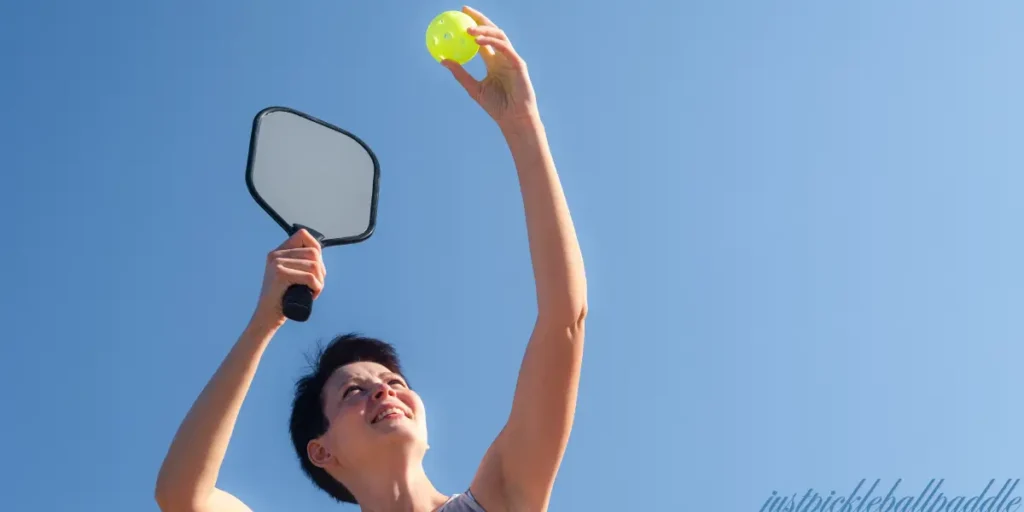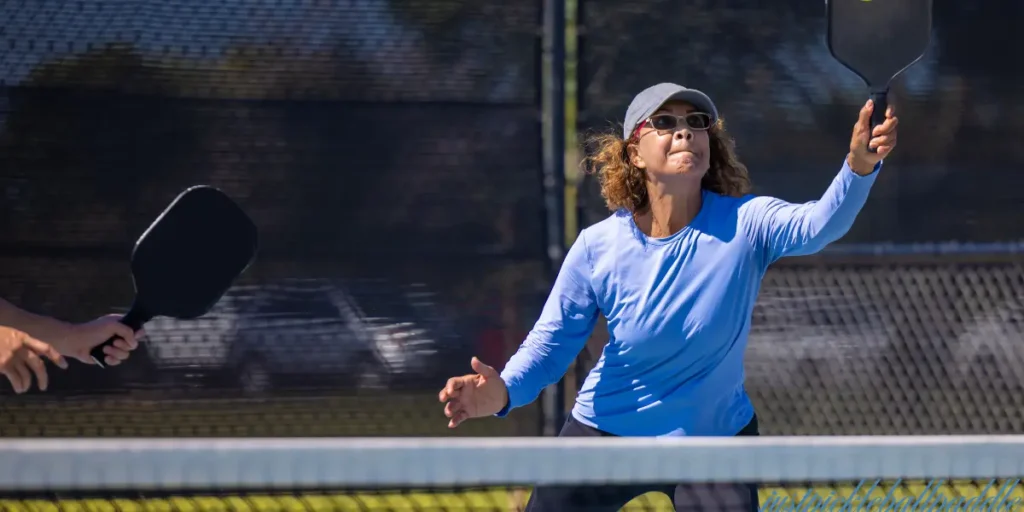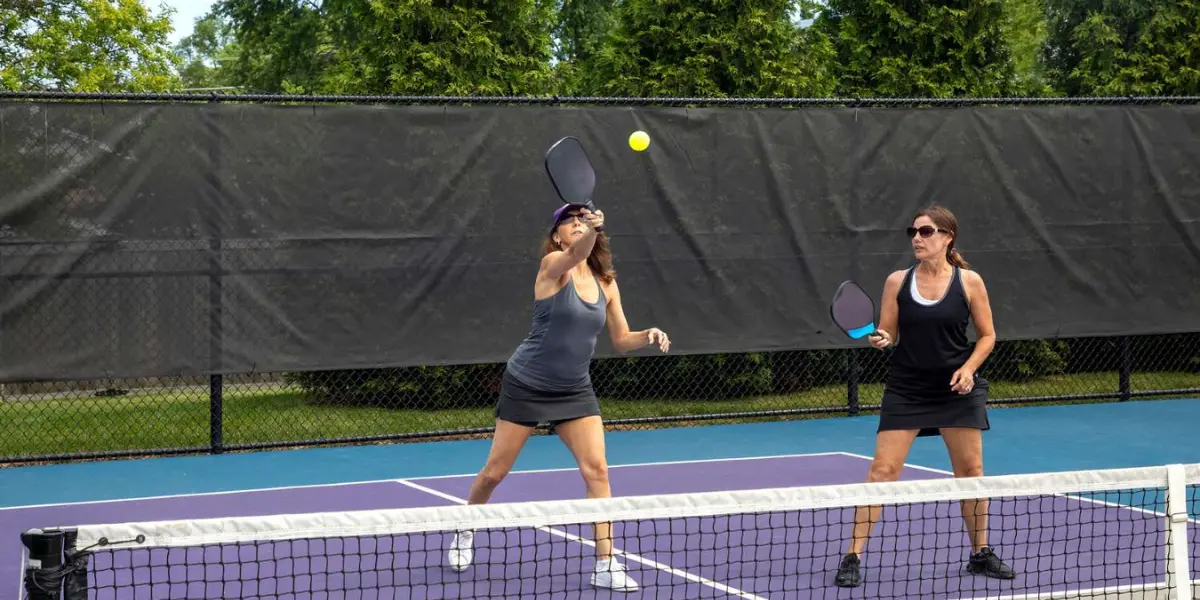Can you hit or serve overhand in pickleball? Many players wonder if they can use an overhand shot while playing or serving. The answer depends on the rules. While some overhand hits are allowed in some situations and overhand serves are not allowed in Pickleball.
In this helpful blog, we will explain when you can hit overhand, why overhand serves are not allowed, and how to improve your game with the right techniques. If you understand these rules they will help you to avoid faults and play more confidently on the court.
When Overhand Hits Are Allowed in Pickleball
Overhand hits are allowed during normal gameplay. Players commonly use them when returning a high ball, especially when the opponent lobs it. One of the most effective ways to use an overhand hit is through a smash, where you strike the ball forcefully downward to make it difficult for your opponent to return.
However, you must be careful not to step into the non-volley zone while making an overhand shot unless the ball has bounced first. Also, your shot must be clean, meaning you cannot hit the ball twice or carry it with the paddle. As long as these conditions are met, you can use overhand shots strategically to win rallies.
Learn more about the rules on Can You Double Hit in Pickleball.
Can You Serve Overhand in Pickleball: Rules and Restrictions

Overhand serves are not allowed in pickleball. The official rules state that all serves must be made using an underhand motion, meaning the paddle must move in an upward direction when striking the ball.
Additionally, the ball must be hit below the waist level, and the paddle head must stay below the wrist at the time of contact. When serving, it’s also important to understand what happens if the ball hits the net on a serve in pickleball to avoid faults and lost points.
These rules ensure fairness and maintain the integrity of the game. Unlike tennis, where players can serve overhand to generate power and speed, pickleball serves are designed to be controlled and strategic rather than overpowering.
If a player attempts an overhand serve, it is considered a fault, meaning they will lose their serve. In doubles, the serve will pass to their partner if it’s the first fault or to the opposing team if both partners have faulted.
Why Overhand Serves Are Not Allowed in Pickleball
The underhand serving rule was created to ensure that all players, regardless of height, strength, or experience, have a fair chance to return the serve. Overhand serves would make the game more difficult for beginners and casual players, giving an unfair advantage to those with a powerful overhand stroke.
By requiring an underhand serve, pickleball promotes longer rallies, strategic gameplay, and a more enjoyable experience for all participants. It also aligns with the sport’s goal of being accessible and easy to learn for new players.
Advantages and Disadvantages of Overhand Hitting

Advantages of Overhand Shots
One of the biggest advantages of overhand shots is the ability to generate power and speed. When used for smashes, an overhand hit can force your opponent into a defensive position, making it difficult for them to return the ball.
Overhand shots are also great for finishing points quickly, especially when your opponent lobs the ball too high.
Another advantage is better control over ball placement. With the right technique, an overhand shot can be directed with precision, helping you attack weak spots in your opponent’s court positioning.
Disadvantages of Overhand Shots
While overhand shots are effective, they come with some limitations. One major drawback is that they cannot be used for serving, as the rules require an underhand motion. Additionally, overhand shots require good timing and positioning—if mistimed, they can result in faults or weak returns.
Another downside is that overhand shots can be risky near the non-volley zone. If a player steps into the kitchen while hitting an overhand shot without allowing the ball to bounce first, they will lose the point.
Techniques for Overhand Hitting in Pickleball
Proper Grip for Overhand Shots
To hit an overhand shot effectively, it is best to use a continental grip. This grip is commonly used for volleys and serves in tennis. It helps maintain a good balance between power and control, making it easier to place the ball accurately.
A strong grip also allows you to generate topspin, which can make your shots more effective. Holding the pickleball paddle correctly is essential for executing a strong overhand hit.
Step-by-Step Guide to Hitting Overhand

Before hitting an overhand shot, you need to position yourself correctly. Move quickly to get under the ball so that you can strike it at the highest possible point. Keeping your feet balanced and your body in the right stance will help you hit with more power and accuracy.
Once you are in position, raise your paddle above your head. Keep your wrist firm but your grip relaxed. A stiff grip can reduce control and accuracy. As you prepare to swing, use a smooth motion and aim downward. Your arm and wrist should generate enough power to send the ball into your opponent’s court with force.
After hitting the ball, follow through with your motion. This means allowing your arm to complete the swing naturally instead of stopping it too soon. A proper follow-through helps maintain control and ensures that your shot lands where you want it to.
Avoiding Common Mistakes When Hitting
One of the most common mistakes players make with overhand shots is rushing the swing. It is important to stay balanced and take your time to execute the shot properly. Swinging too fast without proper positioning can lead to inaccurate shots or mistakes.
Another mistake is stepping into the non-volley zone too early. If you hit an overhand shot while inside the kitchen without letting the ball bounce first, it will result in a fault. Always be mindful of your foot placement and make sure to follow the rules to avoid losing points.
By using the right grip, positioning yourself correctly, and following through with each shot, you can master overhand hitting in pickleball and improve your overall performance on the court.
FAQs
Yes, smashes are allowed in pickleball and are a type of overhand hit. Just ensure you follow the rules for the non-volley zone. Smashes are best used when your opponent lobs the ball too high, allowing you to hit it downward with force. A well-executed smash can make it difficult for your opponent to return the ball effectively.
You can only step into the non-volley zone if the ball has bounced first. Otherwise, it’s a fault. The non-volley zone rule is designed to prevent players from executing aggressive smashes too close to the net, ensuring fair and balanced gameplay. Always check your foot placement before making an overhand shot near the net.
No, you cannot hit an overhand shot from the non-volley zone (kitchen) unless the ball has bounced first. If you attempt to volley an overhand shot while standing in the kitchen, it will be considered a fault.
Avoid using an overhand shot when the ball is too low, as this can lead to errors or weak returns. Also, avoid using overhand shots near the non-volley zone unless the ball has already bounced. In defensive situations, a controlled underhand or sidearm shot may be a better choice.
Yes, professional players frequently use overhand shots, especially for smashes and attacking returns. However, they also know when to avoid overhand shots and use softer, controlled hits to maintain strategic advantage.
Conclusion
Mastering overhand shots in pickleball can give you a strategic advantage, but it’s important to follow the official rules. While overhand smashes are allowed and highly effective for attacking lobs, overhand serves are strictly prohibited. The underhand serving rule ensures fairness, keeping the game accessible for players of all skill levels.
To improve your overhand hitting skills, focus on proper grip, foot positioning, and follow-through. Avoid common mistakes like stepping into the non-volley zone (kitchen) or rushing your swing. Smashes, when used correctly, can help you win rallies and control the pace of the game.
By practicing regularly and understanding when to use overhand shots, you can become a stronger and more confident player. Follow the rules, refine your technique, and enjoy the game of pickleball with better shot precision and strategy!

